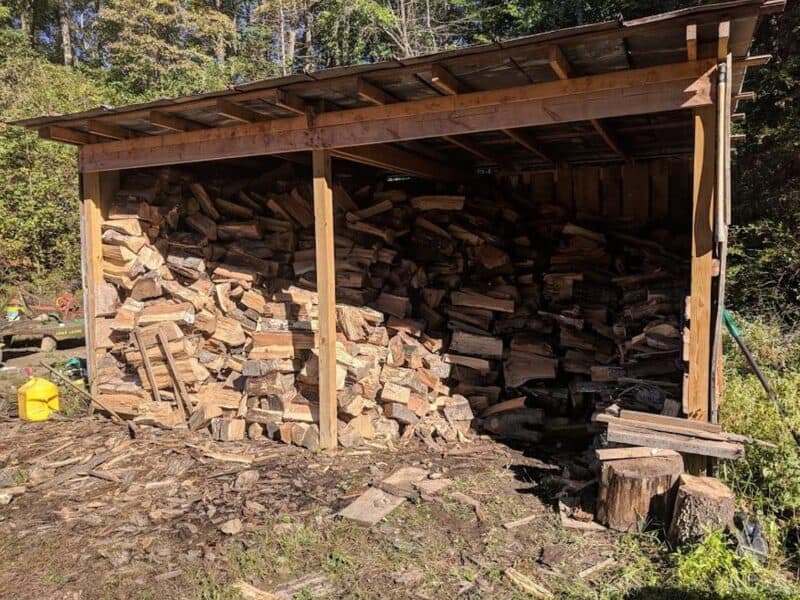If you burn wood for any reason on your homestead, be it for heat in the fireplace or wood stove, or just around the fire pit on a chilly fall evening, you’ve got to have a good supply of firewood on hand if you want to keep it burning brightly.

Staying stocked up on firewood is just another chore that you’ll have to attend to, but with everything to do, I know plenty of homesteaders that still like to buy firewood.
You’ll often see firewood advertised in colder regions by the face cord, a sizable quantity that can usually get you through a few weeks. But how much does a face cord of wood cost?
A face cord of wood will usually run between $75 and $300 depending on the type of wood, the market factors in your area, and how long the wood has been seasoned.
One thing’s for sure, firewood, like everything else, isn’t as cheap as it used to be. That being said, it is still possible to get a deal if you know how to shop, but more importantly, you want to avoid getting ripped off. Keep reading, and I’ll tell you a lot more about the typical pricing factors of face cords…
Local and Regional Markets Affect the Price
The first major factor that will influence the price of a face cord is the local market. Generally, colder regions that see a lot more wood burned for heat will have higher prices, whereas milder, temperate climates usually sell for cheaper.
Likewise, if there is a shortage of wood for any reason, maybe due to blight, consumption, a particularly hard winter, or anything else, you’ll see prices go up in response to demand.
A little investigation will reveal to you what the average going price of a face cord is in your town and neighboring counties.
Seasoning Matters
The seasoning of the wood also matters. Or rather, it should! I wouldn’t pay premium dollars for greenwood that is still months away from being fully seasoned and neither should you.
Expect a seller that has freshly chopped firewood for sale, waiting for you to haul it off, to take less. Make sure you check a cross-section of individual pieces because some of the sneaky people will mix in seasoned and green wood.
Well-seasoned firewood that is ready to go into your fireplace or stove will cost a bit more.
You’ll Pay More in the Winter, Usually
Sad to say, but it makes sense: you’ll be able to get firewood cheaper in the spring and summer when sellers just want it gone compared to the wintertime when they know you need it. This is to be expected, and you shouldn’t give anyone a hard time about it. Again, market factors!
But as I mentioned above, it also pays to get your firewood before you need it. If you’re willing to put in a little more work in the warmer months to haul your firewood home and get it stacked and covered, you can save a bundle.
Hardwoods are More Expensive than Softwoods
Make sure to ask your seller what kind of wood is in the cord. A rule of thumb is that you should pay less for softwoods which offer less overall heating value and somewhat lower peak heat compared to hardwoods which are long and hot burning.
Pine, for instance, is good enough, but hardwoods like maple, oak, cherry, and ash have many advantages and will cost accordingly. Once again, depending on your region, this might be a small premium or a significant difference in cost so you should check ahead of time.
Always Double Check the Stack to Make Sure You Don’t Get Cheated
And last but not least, always make it a point to verify the size of a face cord so you know you aren’t spending too much. A face cord of wood should be 8 feet long, 4 feet tall, and anywhere from 16 to 18 inches deep.
If you want to get really specific, you should be getting between 42 ½ and 48 cubic feet of wood. The wood in the stack should be tightly packed with few large gaps, and each piece should be consistently sized, give or take a half inch to an inch.
Unscrupulous sellers will stack a cord haphazardly to reduce the overall cubic volume, meaning that you’ll be paying more per unit of wood.
Bust out your tape measure and check the size of the cord yourself so you don’t get cheated, and any upright and honest seller should not take offense.
Tom has lived and worked on farms and homesteads from the Carolinas to Kentucky and beyond. He is passionate about helping people prepare for tough times by embracing lifestyles of self-sufficiency.
